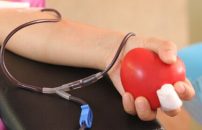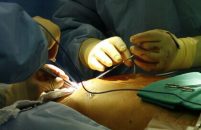Almost 30% of all patients experience some degree of myocardial injury after elective angioplasty, a statistic associated to an increase in cardiovascular events at 30 days and 1 year, according to this study recently published in Eur Heart J. The study only included consecutive patients who underwent elective angioplasty with a negative troponin level at admission. The…
Peri-Procedural Infarction: More Frequent than and Not as Innocent as We Thought
Almost 30% of all patients experience some degree of myocardial injury after elective angioplasty, a statistic associated to an increase in cardiovascular events at 30 days and 1 year, according to this study recently published in Eur Heart J. The study only included consecutive patients who underwent elective angioplasty with a negative troponin level at admission. The…
ACC 2018 | Risk of MI in Non-Cardiac Surgeries
One in five patients presenting perioperative MI during non-cardiac surgery should be readmitted within 30 days after surgery, and one in seven dies within the same period, according to the new study presented at ACC 2018 scientific sessions and simultaneously published in Circulation. These infarctions could be considered a iatrogenic complication, given the obvious lack of proper…
ACC 2018 | SECURE-PCI: High Dose of Statins pior PCI Could Help
Patients undergoing acute coronary syndrome (ACS) loaded with a high dose of statins prior diagnostic catheterization do not seem to benefit from this strategy. However, when looking at those undergoing PCI alone (excluding all patients who had received surgery or medical treatment), the benefit appears as a reduction of combined major events. The benefit of atorvastatin loading…
ACC 2018 | SMART-DATE: 6 Month DAPT Results Suboptimal in ACS
This study compared 6 vs 12 or more months of dual antiplatelet therapy (DAPT) in patients undergoing acute coronary syndrome (ACS) receiving contemporary DES, and it did not find differences in combined endpoint. However, looking at primary endpoint components separately, there were more infarctions in patients with a short DAPT scheme that we cannot ignore. Prolonging antiaggregation…
ACC 2018 | DEFINE-FLAIR Sub-Analysis: iFR More Comfortable, Faster, and Much Cheaper
Using instantaneous wave-free ratio (iFR) to guide decisions on revascularization of intermediate lesions is cheaper than using fractional flow reserve (FFR). Based on costs from the DEFINE-FLAIR trial, researchers estimate the difference to be almost USD 1000. This should not be seen as good news for any given technology (iFR, in this case), but for physiologic…
ACC 2018 | COMBO: New Stent with Thin Struts and Pro-Healing Membrane
The new COMBO stent, comprised of thin struts plus a bioengineered layer of endothelial progenitor cells, is safe and effective at 1 year, according to this registry (the largest study on this device to date). This new stent could provide a better option for patients at high risk for bleeding who may not be able to…
Tips to Prevent Radial Occlusion after Catheterization
The transradial access is the preferred access site for patients undergoing acute coronary syndrome. Compared to the transfemoral access site, it reduces the risk of all cause death, vascular complications and major bleeding. Radial artery occlusion is the most frequent vascular complication associated to this approach, though it rarely results in clinical consequences such as ischemia, given the…
Surgery Seems Superior to Angioplasty in Young Patients
Long-term follow-up of patients under 50 with multivessel coronary artery disease suggests surgery outcomes are significantly better than angioplasty outcomes. This study, presented at the Society of Thoracic Surgeons’ (STS) Annual Meeting, concludes that surgery should continue as plan A when it comes to young patients with three-vessel disease. Surgeons complain that many patients never actually…
Silent Diabetes Is the New Stealthy Enemy
One in three “nondiabetic” patients who undergo angioplasty with current drug-eluting stents have an altered glucose metabolism, which is associated with a 4-fold higher risk of events, according to a study that will be published soon in JACC Intv. One in three patients is definitely one patient too many, and four times higher is definitely…
Complete Revascularization Is Beneficial in Acute MI with Cardiogenic Shock
Around half of all cases of ST-segment elevation acute myocardial infarction (STEMI) come alongside lesions in another vessel, for which the current strategy is complete revascularization in one or two steps. However, there are no large-scale studies analyzing patients who also present cardiogenic shock; we only have observational studies with inconclusive results influenced by several…










